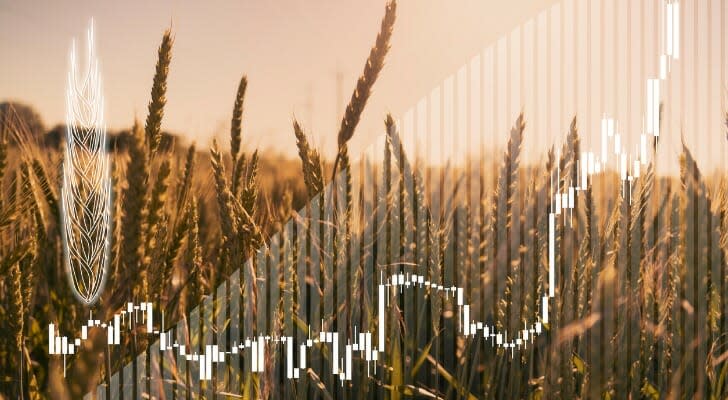Can Investing in Wheat Help Me Hedge Against Inflation?
Wheat is one of the world’s most widely grown crops, which can make it an attractive investment. Investors use wheat to diversify, as a hedge against inflation and in search of profit as the cultivation and use of wheat increases in many countries. Investing in wheat can be accomplished by purchasing wheat exchange-traded funds, shares of companies in businesses related to wheat and by trading wheat commodity futures contracts. A financial advisor can help you decide how and whether to include wheat in your portfolio.
Wheat Investing Background
Wheat is grown for human consumption and to feed livestock. Most wheat is ground into flour and used to make bread and similar food products, but it is also used to make beverages and in some industrial processes. Cultivation of wheat began millennia ago and today it is the world’s second-most popular grain behind only corn.
As an investment, wheat is classified as a commodity. It is not as popular an investment as stocks and bonds, but wheat investments offer some appealing characteristics that can help investors manage risk and increase returns.
Diversification is one common reason for investing in wheat and other commodities. The prices of commodities typically move opposite to prices for stocks and bonds. Including commodities such as wheat in a portfolio can help counter declines in the securities markets and smooth returns.
Wheat can also serve as a hedge against the effects of inflation. When inflation rises, cash loses value while prices for commodities such as wheat rise. Investing in wheat can help a portfolio keep pace with inflation, even if other markets are on the decline.
Additionally, wheat has traits of growth investment. Wheat consumption grows as the global population grows. In developing economies people tend to eat more meat as their economic prosperity increases and wheat’s importance as a livestock feed also helps to ramp up demand.
Wheat attracts commodity investors because its production is not geographically concentrated. Some commodities are dominated by a single region or even a single producer. Most cocoa, for instance, comes from West Africa with the country of Ivory Coast contributing more than a third of the global supply. Wheat production is broadly dispersed among many countries led by China, India, Russia and the United States.
Ways to Invest in Wheat
Investors have limited options for investing in wheat. There is, for example, no mutual fund investing specifically in wheat, although there are mutual funds focused on agricultural products in general. Nor is there any public company that is strictly in the wheat business.
Several ways to invest in wheat still exist, however. They range from easy, such as purchasing shares of a wheat exchange-traded fund, to more complex, such as trading wheat commodity futures. Here are the ways investors can invest in wheat:
Trading in commodities: Particularly in the form of wheat futures contracts, is one way to gain exposure to wheat. These agreements to buy or sell wheat at a future date for a set price trade on the Chicago Board of Trade. Commodities investors are not actually buying sacks of grain. They are trading derivatives whose value is based on the value of the wheat that is the underlying asset. Trading wheat futures directly is complicated and risky and generally reserved for sophisticated investors.
Exchange-traded funds (EFTs): Trade like shares of individual public companies but, like mutual funds, each share represents ownership of a portion of a basket of securities. ETFs typically track indexes and many ETFs are invested in commodities. One ETF, the Teucrium Wheat Fund, invests in wheat commodity futures contracts. ETFs are easy to buy and sell and viewed as less risky than trading futures directly.
Stocks: Investors who prefer stocks can purchase shares of individual companies that produce, process or supply wheat-related equipment to the wheat business. One example is Deere & Co., maker of tractors and combines widely used by farmers. While there are no pure-play wheat stocks, shares in companies such as Deere provide exposure to the broader agricultural sector.
Factors Affecting Wheat Investments
Wheat investments can fluctuate in value like any other investment. The wheat market is affected by factors including population growth, weather, supply chain disruptions and currency fluctuations. Droughts, for instance, can lead to declines in wheat production and cause wheat prices to rise.
Geopolitical developments represent another source of influence on wheat investments. Russia’s 2022 invasion of Ukraine, for instance, disrupted wheat production and distribution from both countries. Russia and Ukraine are each among the leading growers of wheat globally, so wheat prices spiked afterward.
The Bottom Line
Wheat is one of the world’s most popular agricultural products and can be used by investors to hedge against inflation, diversify to manage risk and generate returns from rising global demand. Options for investing in wheat include wheat-focused ETF shares, public companies in wheat-connected industries and wheat commodities futures contracts.
Tips for Investing
Consider talking to a financial advisor about ways to diversify your portfolio and protect against inflation. If you don’t have a financial advisor, finding one doesn’t have to be hard. SmartAsset’s free tool matches you with up to three vetted financial advisors who serve your area, and you can interview your advisor matches at no cost to decide which one is right for you. If you’re ready to find an advisor who can help you achieve your financial goals, get started now.
SmartAsset’s Investment Return & Growth Calculator will tell you how much your investment will be worth at a given point in the future. After you provide your starting amount, frequency and amount of additional contributions, expected rate of return and investment time horizon, the calculator will estimate the future value of your investment.
Photo credit: ©iStock.com/Scharfsinn86, ©iStock.com/Daniel Balakov, ©iStock.com/gerenme
The post How to Invest in Wheat appeared first on SmartAsset Blog.

 Yahoo Finance
Yahoo Finance 


